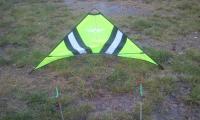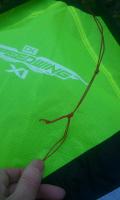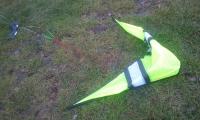20 first minutes of Speedwing - a really short session for a change
Mon Dec 25 13:00:00 CET 2017
GB, Forecasted 4m/s (gusts 8m/s)
Cross Kites Speedwing X1
25m 38kg lines

Looks small (113cm span), but is capable of surprising you (much like the Monty Python monster rabbit https://www.youtube.com/watch?v=cCI18qAoKq4 ?). Looks wrinkled as well? Don't worry - once in the air everything gets smooth.
Conditions/background: Quite OK wind, but I still wouldn't hesitate to trick trickable kites. Rain on frozen ground... My flick flack exercising earlier during the day felt a bit stalled, so switching to something completely new felt like a fresh breeze.
Much is speedy about this kite:
- Assembly is just one spreader. No standoffs. No battens. No bridle/standoff tangle.
- Nose back/forward bridle adjustment is only one knotted line/larks head.
- Speed (obviously) forward and angular speed (though not necessarily very tight/small radius).
So, except for the above, what is this kite anyhow? - A no spine speed kite with a deep (strange looking) bridle! Bought it mostly to see and learn how it was made.
First launch, nose angle was medium setting - no problems to launch. No problems to control - until getting close to the edge of the wind window. Kite just tumbled out of control to the ground. No standoffs - didn't even try to avoid the walk of contemplation therefore. I guess there could be two reasons for the difficulties here. If you have no spine, you don't have this flatter area around the spine to fly on when the flow around the wing tip fails to function at the edge of the wind window (think of the varying angles of attack along the span of an ordinary DLK). For the Speedwing the whole wing seems to fail at once it appears. Add to this that you are likely to have some momentum forward (due to the high speed) when you enter the edge of the wind window, driving you a longer bit into it than when using trick kites. Also when the sail fails, there are no standoffs that holds it in place, so you can more or less pull the lines and frame, but there is little effect on the sail once it goes non-filled. As you might have guessed, stalling and tricking - no success there. Stayed away from the edges and more trick attempts and had no further problems when using the medium nose back/forward angle setting.

A larks head knot under a bridle setting knot gets you the best of two worlds. First an easy launch. Once in the air the kite starts to pull and the larks head slides out to the outmost knot. Now you are in nose back "speed kite mode".
It felt "fresh", speedy and a pull that "shouldn't" be in such as small kite, but I wanted more, so I adjusted the nose back. The following start then failed - just tumbling around with no forward drive. Then (I'm proud to say) I got an idea. Why not adjust the nose forward to the medium setting, but instead put the larks head just under the mid one of the overhand knots in the nose. During the launch the nose was enough forward to give a simple launch, but in the air when the kite started to pull, the larks head slided down to the outmost knot giving the kite a nose back speed kite like angle - and this just worked out of the box (I'm sure such a simple and efficient fix must be a standard launching method?)!
The turns got tighter after the adjustment, but don't make them to tight to preserve full pull/speed. In gusts the lines begun to sing (even in the centre of the wind window) and the sail gave a swosh like sound (much like when powering up a Rev QLK without having a flapping trailing edge). Normally for DLK trick kites I get the singing when "parking" them at the edge of the wind window (for the Speedwing I just avoided the edge because the kite had just fallen out of the air there previously).
The kite was quite easy to control, not at all like my few and very short attempts with the Atrax. Even some limited (and quick) figure flying was possible: straight lines, 180 deg turns, squares, circles, figure eights. After a while I begun to think how to land it. Stalling didn't seem to be easy, so I flung my arms forward to kill the forward drive. It worked well, say 5m from the ground it kind of entered a mode resembling the tumbling start when the nose had been adjusted in this nose most backwards position. To recover from the tumbling it was sufficient to pull one line rather much for a moment. I guess the angle of the kite to the wind changed so it got some at least sideways drive. How the nose of the kite caught up with the direction the kite was going in I didn't get even at the time. Returning to the landing attempts, I just flung the arms forward once again but without making any tumbling recovery attempt. The kite then tumbled to the ground.

The disassembly was even quicker. When the kite had tumbled down to land, the only spreader had already slid out of the fitting on one side.
Much wind a problem? - No I look forward to more of it! The kite is small so it could be in the bag as some kind of high wind insurance, though I should have some slightly longer and stronger lines as well for the really windy days. And who knows, getting enough experience with the Speedwing, I might later even learn the Spiderkites Atrax. I was quite happy with the session - 20 much interesting minutes where much was not familiar.



1 Comment
Recommended Comments